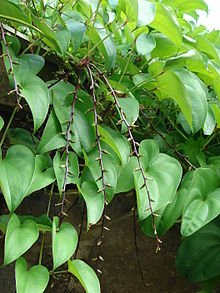Dioscorea alata

Dioscorea alata, also known as purple yam, ube (/ʊbɛ/), or greater yam, among many other names, is a species of yam (a tuber). The tubers are usually a vivid violet-purple to bright lavender in color (hence the common name), but some range in color from cream to plain white. It is sometimes confused with taro and the Okinawa sweet potato (Ipomoea batatas cv. Ayamurasaki), although D. alata is also grown in Okinawa where it is known as beniimo (紅芋). With its origins in the Asian tropics, D. alata has been known to humans since ancient times.[3]
Dioscorea alata is one of the most important staple crops in Austronesian cultures. It is one of various species of yams that were domesticated and cultivated independently within Island Southeast Asia and New Guinea for their starchy tubers, including the round yam (Dioscorea bulbifera), ubi gadong (Dioscorea hispida), lesser yam (Dioscorea esculenta), Pacific yam (Dioscorea nummularia), fiveleaf yam (Dioscorea pentaphylla), and pencil yam (Dioscorea transversa).[4] Among these, D. alata and D. esculenta were the only ones regularly cultivated and eaten, while the rest were usually considered as famine food due to their higher levels of the toxin dioscorine which requires that they be prepared correctly before consumption.[5] D. alata is also cultivated more than D. esculenta, largely because of its much larger tubers.[6]
D. alata and D. esculenta were the most suitable for long transport in Austronesian ships and were carried through all or most of the range of the Austronesian expansion. D. alata in particular, were introduced into the Pacific Islands and New Zealand. They were also carried by Austronesian voyagers into Madagascar and the Comoros.[7][8][9]
Aerial tuber of a white variety of D. alata from Maui, Hawaii
The center of origin of purple yam is unknown, but archaeological evidence suggests that it was exploited in Island Southeast Asia and New Guinea before the Austronesian expansion. Purple yam is believed to be a true cultigen, only known from its cultivated forms. The vast majority of cultivars are sterile, which restricts its introduction into islands purely by human agency, making them a good indicator of human movement. Some authors have proposed, without evidence, an origin in Mainland Southeast Asia, but it shows the greatest phenotypic variability in the Philippines and New Guinea.[10][11][12][13][14]
